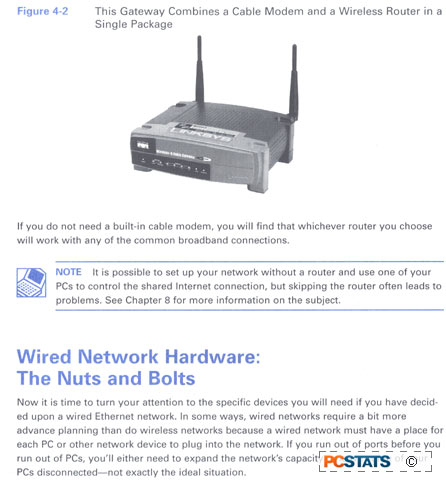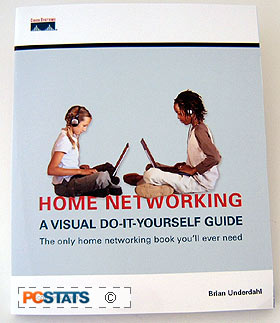Given that Linksys is now a division of
Cisco, this bias is not particularly
surprising, but it does get irritating when almost every reference to networking
hardware in the book is accompanied by a Linksys model number. It's easy to see
the networking newcomer (the target market) not realizing that there are
effective alternatives to Linksys available such as 3Com, SMC, D-Link, Belkin,
Netgear and Trendware. Worse, the reliance on Linksys hardware makes several of
the step-by-step guide sections, notably those concerning home routers, mostly
irrelevant to users who are not using the 'correct' devices.

The fact is, most home routing
devices do operate in a similar manner. With this in mind, there should still be
benefit in the step-by-step guide sections even for non-Linksys users, except
that no attempt has been made to inform the reader of any measures that should
be taken to compensate for their differing equipment when using the guides.
As one example, Linksys
routers generally use '192.168.1.1' as their default IP address. Other
manufacturers use different numbers for their routers, but the book makes no
mention of this possibility. It simply tells the reader to enter '192.168.1.1'
to access the control panel of their Linksys router. While you can safely assume
that the majority of readers faced with the lack of a Linksys router would
(after a brief period of confusion) consult their own router's manual for the
correct address, I have a feeling that this kind of inflexibility will lose some
readers.
This is unfortunate, as a
brief aside to the tune of 'if you are not using a Linksys router, consult your
documentation for the correct IP address.' Would do wonders to increase the
friendliness and usability of this guide. Cisco Press and the author seem to be
sacrificing some of their book's usefulness to beginners for the sake of selling
more hardware, which is unfortunate and shortsighted. To be fair, Linksys does
make excellent networking equipment, so it's not like the reader who buys into
the theme is being led astray.
Conclusions
I have mixed feelings about
Cisco's "Home Networking: A Visual Do-It-Yourself Guide". On the one hand,
it's a simple to read, affordable and comprehensive guide containing everything
the network newbie needs to know about setting up his or her network. This goal
is accomplished without unnecessary technical information getting in the way,
but without dumbing things down and insulting the reader either. This is always
a fine balancing act for computer publications targeted at beginners, and the
author, Brian Underdahl, pulls it off well. Cisco's Home Networking: A Visual
Do-It-Yourself Guide is well written throughout, and effectively illustrated.
 On the other
hand, there were a couple of troubling omissions. Most notable was the
absence of any sort of information on router firewalls. If you are
going to advise a user to purchase a device containing a firewall, you need to
tell them how to use it, or at least tell them it's
there.
On the other
hand, there were a couple of troubling omissions. Most notable was the
absence of any sort of information on router firewalls. If you are
going to advise a user to purchase a device containing a firewall, you need to
tell them how to use it, or at least tell them it's
there.
The book's failure to do this could lead to intense
frustration on the part of users trying to run peer-to-peer file sharing, or
voice chat software on their networks, to mention just two potential trouble
areas. The complete reliance on Linksys hardware throughout the book is a
negative also, as few steps have been taken to help those users who may not
choose to buy Linksys devices or currently own other brands of networking
hardware.
Yet on the whole, PCstats
opinion of this 175pg book is positive. The missing elements do not
outweigh the overall usefulness of Cisco's "Home Networking: A Visual
Do-It-Yourself Guide". As we said, the non-technical reader we got to look at it
gave it high marks, which to us means that the book is hitting its
target.

